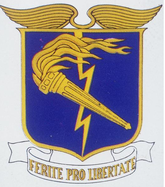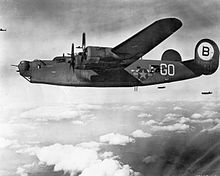93rd Operations Group
This article includes a list of generalreferences,butit lacks sufficient correspondinginline citations.(March 2017) |
| 93d Operations Group | |
|---|---|
 WingE-8 J-STARSaircraft | |
| Active | 1942–1952; 1991–1995; 1996–2002 |
| Country | |
| Branch | |
| Role | Air control |
| Nickname(s) | Traveling Circus (World War II) Blaze[citation needed] |
| Decorations | Distinguished Unit Citation[1] |
| Insignia | |
| 93d Operations Group emblem[1][note 1] |  |
| 93d Bombardment Group emblem[2] |  |
The93d Operations Groupis an inactiveUnited States Air Forceunit. Its last assignment was with the93d Air Control Wing,stationed atRobins Air Force Base,Georgia. The unit was inactivated on 1 October 2002.
During World War II, the group's predecessor unit, the93d Bombardment Groupwas the firstVIII Bomber CommandConsolidated B-24 Liberatorgroup to bomb targets inOccupied EuropeandNazi Germany.It flew fromRAF AlconburyinCambridgeshire.The group became operational with a mission over Occupied France on 9 October 1942.
In the postwar era, the 93d Bombardment Group was one of the original ten USAAF bombardment groups assigned toStrategic Air Commandon 21 March 1946. Equipped with low-hourBoeing B-29 Superfortresssurplus World War II aircraft, the group deployed toFar East Air Forcesduring the early part of theKorean War,and flew combat missions over Korea. The group was inactivated in 1952 when the parent wing adopted the dual deputy organization and assigned all of the group's squadrons directly to the wing.
It was reactivated as the 93d Operations Group in 1991 when the wing adopted the USAF objective organization.
History
[edit]- For related history and lineage, see93d Air-Ground Operations Wing
World War II
[edit]


The93d Bombardment Groupwas activated on 1 March 1942. It initially prepared for combat withConsolidated B-24 Liberators.Engaged in antisubmarine operations over the Gulf of Mexico and the Caribbean Sea as part of theIII Bomber Command,May– July 1942.
The group moved to England, August– September 1942, and was assigned to Eighth Air Force. It was assigned to the2d Combat Bombardment Wing.The group flew itsB-24 Liberatoraircraft with a tail code of"Circle B".The 93d was the first Liberator-equipped bomber group to reach the Eighth Air Force. The group became operational with the B-24 on 9 October 1942 by attacking steel and engineering works atLilleFrance. Until December, the group operated primarily againstsubmarine pensalong the French coast along theBay of Biscay.
While the 93d was at RAF Alconbury, His Majesty,King George VIpaid his first visit to an Eighth Air Force base on 13 November 1942. During the visit, he was shown the B-24 "Teggie Ann", then considered to be the 93d's leading aircraft.
On 6 December 1942 most of the group was transferred toTwelfth Air Forcein North Africa to support theOperation Torchlandings. The group receiving aDistinguished Unit Citationfor operations in that theatre, December 1942 – February 1943, when, with inadequate supplies and under the most difficult desert conditions, the detachment struck heavy blows at enemy shipping and communications. The detachment returned to England in February 1943, where its personnel were featured on the cover of the 26 July 1943 issue ofLife Magazineand the unit dubbed "Ted's Traveling Circus" after its first commander, Col. Edward J. Timberlake.
The balance of the 93d BG was moved toRAF Hardwick(Station 104), in Norfolk where B-24 groups were being concentrated. From February 1943 and until the end of June the group bombed engine repair works, harbors, power plants, and other targets in France, the Low Countries, and Germany.
A detachment returned to the Mediterranean theatre during June and July 1943 to support theAllied invasion of Sicilyand to participate in the famouslow-level attack on enemy oil installations at Ploestion 1 August. Having followed another element of the formation along the wrong course to Ploesti, the 93d hit targets that had been assigned to other groups, but it carried out its bombing of the vital oil installations despite heavy losses inflicted by attacks from the fully alerted enemy and was awarded aDistinguished Unit Citationfor the operation.
After the detachment returned to England in August 1943, the group flew only two missions before the detachment was sent back to the Mediterranean to support theFifth ArmyatSalernoduring theinvasion of Italyin September 1943.
The detachment rejoined the group in October 1943, and until April 1945 the 93d concentrated on bombardment of strategic targets such as marshalling yards, aircraft factories, oil refineries, chemical plants, and cities in Germany. In addition it bombed gun emplacements, choke points, and bridges nearCherbourg-en-Cotentinduring theNormandy invasionin June 1944. It attacked troop concentrations in northern France during theSaint-Lôbreakthrough in July 1944; transported food, gasoline, water, and other supplies to the Alliesadvancing across France,August – September 1944; dropped supplies toairborne troops in the Netherlandson 18 September 1944; struck enemy transportation and other targets during theBattle of the Bulge,December 1944 – January 1945; and flew two missions on 24 March 1945 during theairborne assault across the Rhine,dropping supplies to troops nearWeseland bombing a night-fighter base at Stormede.
The 93d Bombardment Group ceased combat operations in April 1945, and returned toSioux Falls Army Air FieldSouth Dakota during May/June for B-29 Superfortress transition training, prior to deployment to the Pacific Theater. However, the deployment never took place as the war in the Pacific ended. The group was demobilized and was eventually inactivated in December 1945.
Strategic Air Command
[edit]The 93d Bombardment Group (Very Heavy) was activated at Merced Field, California on 21 June 1946 which was assigned to Merced forBoeing B-29 Superfortresstraining. The 93d was one of SAC's first ten bomb groups. There were three initial operational squadrons (328th,329th,and330th Bombardment Squadrons) which absorbed the equipment and aircraft of the inactivated444th Bombardment Group.
On 1 October 1946 the airfield was put on "minimal operations on caretaker status", with control of the facility under Colorado Springs AAF. The 93d Bomb Group, however remained active. It, along with the509th Composite GroupatRoswell Army Air Field,New Mexico, was all there was ofStrategic Air Commandat that time. The airfield remained in this status until 1 May 1947 when it was reactivated.
On 1 May 1947,Merced Army Air Fieldwas reactivated under Strategic Air Command. On 28 July 1947, the group became the93d Bombardment Wing,Very Heavy and took host unit responsibility from the group as part of theWing Base organization plan.During 1947–1948, it flewBoeing B-29 Superfortresses,but soon received the upgraded version of the B-29, theBoeing B-50A Superfortress.In 1948, the entire group deployed toKadena Air Base,Okinawa,becoming the first Strategic Air Command bomb group to deploy in full strength to the Far East.
Upon its return to Castle in 1951, the group was re-equipped with B-50s. In June 1952 the group was inactivated when Strategic Air Command reorganized its wings into the dual deputate system.
Reactivation
[edit]On 1 September 1991, the 93d Bombardment Wing was redesignated as the 93d Wing under the "Objective Wing" concept adopted by the Air Force. The flying components of the wing were reassigned to the newly renamed93d Operations Group.
As part of their new mission, the 93d Group also gained theBoeing B-52 Stratofortresssquadrons from the 93d Wing. However, the operations of the reestablished group was short, On 1 June 1992 the 93d was relieved from assignment to SAC and was reassigned to the newly formedAir Combat Command(ACC). Its B-52G aircraft given the ACC tail code of "CA" and carried blue tail stripes. The 328th Bomb Squadron was inactivated 3 May 1994, and the wing and group were placed on non-operational status. The group was inactivated on 31 October 1994.
Just four months later, however, it was reactivated as the operational arm of the93d Air Control Wingand was reactivated atRobins Air Force Base,Georgia on 29 January 1996. It was equipped with theBoeing E-8 Joint STARSand it accepted its first production aircraft on 11 June 1996.
Some crews and aircraft deployed from Robins to Bosnia-Herzegovina in 1996 to support theOperation Joint Endeavorpeacekeeping operation. Deployed to Southwest Asia in response to Iraq's refusal to cooperate with United Nations weapons inspectors, 18 February – 3 June 1998. Between 23 February – 28 June 1999, deployed aircraft and personnel toRamstein Air Base,Germany to assist in monitoring Serbian withdrawal from Kosovo.
Upon inactivation on 1 October 2002; Georgia Air National Guard's116th Air Control Wingassumed command responsibility for JSTARS mission.
Lineage
[edit]- Constituted as the93d Bombardment Group(Heavy) on 28 January 1942
- Activated on 1 March 1942
- Redesignated93d Bombardment Group,Heavy in c. 20 August 1943
- Redesignated93d Bombardment Group,Very Heavy c. 6 July 1945
- Redesignated93d Bombardment Group,Medium c. 28 May 1948
- Inactivated on 16 June 1952[3]
- Redesignated93d Operations Groupon 28 August 1991
- Activated on 1 September 1991
- Inactivated on 31 October 1994
- Activated on 29 January 1996
- Inactivated on 1 October 2002
Assignments
[edit]- III Bomber Command,1 March-2 August 1942
- 1st Bombardment Wing,6 September 1942
- 2d Bombardment Wing,6 December 1942
- Attached to: 201st Provisional Combat Bombardment Wing, 25 March-13 December 1943
- 20th Combat Bombardment Wing,13 September 1943 – 12 June 1945
- Second Air Force,June 1945
- Strategic Air Command, 21 March 1946
- Fifteenth Air Force,21 June 1946
- 93d Bombardment Wing,28 July 1947 – 15 June 1952 (detached toFar East Air Forces,15 May-25 August 1948, Far East Air Forces Bomber Command, 15 July 1950 – 30 January 1951, not operational after 10 February 1951)[4]
- 93d Wing (later 93d Bomb Wing), 1 September 1991 – 31 October 1994[4]
- 93d Air Control Wing, 29 January 1996 – 1 October 2002[4]
Components
[edit]- 12th Airborne Command and Control Squadron:29 January 1996 – 1 October 2002
- 16th Airborne Command and Control Squadron:29 January 1996 – 1 October 2002
- 93d Training Squadron: 29 January 1996 – 1 October 2002
- 328th Bombardment Squadron:1 March 1942 – 15 June 1952;[3]1 September 1991 – 31 October 1994
- 329th Bombardment Squadron:1 March 1942 – 15 June 1952[3]
- 330th Bombardment Squadron:1 March 1942 – 15 June 1952[3]
- 409th Bombardment Squadron:1 March 1942 – 6 July 1945; 20 August 1945 – 6 May 1946[3]
- 924th Air Refueling Squadron:1 September 1991 – 31 October 1994
Stations
[edit]
|
|
Aircraft
[edit]- Consolidated B-24D/H/J/L/M Liberator, 1942–1945, 15 May-25 August 1948,
- Boeing B-29 Superfortress, 1945–1949; 1950–1951, 15 May-25 August 1948,
- Boeing B-50 Superfortress, 1949–1950; 1950–1952, 15 May-25 August 1948,
- Boeing B-52G Stratofortress, 1991–1994
- Boeing E-8 Joint STARS, 1996–2002
References
[edit]- Notes
- ^The group uses the wing emblem with the group designation on the scroll. Air Force Instruction 84-105, Organizational Lineage, Honors and Heraldry, 19 March 2013, para 3.3.3
- Citations
Bibliography
[edit]![]() This article incorporatespublic domain materialfrom theAir Force Historical Research Agency
This article incorporatespublic domain materialfrom theAir Force Historical Research Agency
- Freeman, Roger A. (1978)Airfields of the Eighth: Then and Now.After the BattleISBN0-900913-09-6
- Freeman, Roger A. (1991)The Mighty Eighth The Colour Record.Cassell & Co.ISBN0-304-35708-1
- Maurer, Maurer, ed. (1983) [1961].Air Force Combat Units of World War II(PDF)(reprint ed.). Washington, DC: Office of Air Force History.ISBN0-912799-02-1.LCCN61060979.Retrieved17 December2016.
- Maurer, Maurer, ed. (1982) [1969].Combat Squadrons of the Air Force, World War II(PDF)(reprint ed.). Washington, DC: Office of Air Force History.ISBN0-405-12194-6.LCCN70605402.OCLC72556.Retrieved17 December2016.
- Ravenstein, Charles A. (1984).Air Force Combat Wings, Lineage & Honors Histories 1947-1977.Washington, DC: Office of Air Force History.ISBN0-912799-12-9.Retrieved17 December2016.
- Watkins, Robert (2008).Battle Colors: Insignia and Markings of the Eighth Air Force in World War II.Vol. I (VIII) Bomber Command. Atglen, PA: Shiffer Publishing Ltd.ISBN978-0-7643-1987-7.
External links
[edit]- The 93 Bomb Group Museum,Station 104, Hardwick. A small museum in Norfolk, UK dedicated to USAAF World War II activities.




